China Insight
A Snowball Effect: How Cold Harbin Became the Hottest Place in China
Part of Harbin’s enormous success can be attributed to a snowball effect, but the hype is also the result of a well-coordinated campaign.
Published
1 year agoon

PREMIUM CONTENT
There is one topic that has been dominating Chinese social media recently: Harbin and its remarkable influx of tourists. How can the buzz surrounding this frosty city be explained?
The new year has just started and Harbin already seems to be the hit of 2024. The capital of China’s Heilongjiang Province, which is famous for its Ice and Snow Festival and Russian heritage, has been dominating trending topics on Chinese social media from late December well into this second week of January.
Every day recently, there’s another hashtag about Harbin that is hitting the hot charts on Chinese social media platforms Weibo, Douyin, and Xiaohongshu. Whether it is about Harbin travel, food, or funny memes, there seems to be an endless stream of stories and topics coming from the city in China’s northeast.
The sudden hype surrounding Harbin is similar to that of Zibo in 2023. The Shandong city, known for its local BBQ culture, became all the rage in spring of last year for its joyful atmosphere and post-pandemic celebratory mood.
Is Harbin the ‘Zibo’ of this 2023-2024 winter season? How come the historical city became such a social media phenomenon?
Harbin’s Hottest Festival
This year marks the 40th edition of the Harbin International Ice and Snow Festival (哈尔滨国际冰雪节), which is the largest ice and snow festival in the world. The official opening ceremony on January 5th not only celebrated the milestone of the 40th edition but also highlighted Harbin’s role as the host city for the 2025 Asian Winter Games. This will also be the first festival after the end of China’s ‘Zero Covid’ policy (the event was previously still held but kept much smaller).
Harbin winters are tough, with temperatures plummeting to as low as minus 30 degrees Celsius (minus 22 degrees Fahrenheit) or even colder. The idea for a Harbin ice festival first emerged in the late 1950s, when local officials wanted to cheer up the city and its residents in the dark and gloomy winter days.
They therefore introduced a winter festival centered around the idea of ice lanterns, of which the history goes back to the fisherman on the Songhua River using candles inside frozen blocks to give light on long winter nights. The festival was successful from the start; nearly 250,000 people participated in the 1963 edition (Dewar et al 2001, 524).
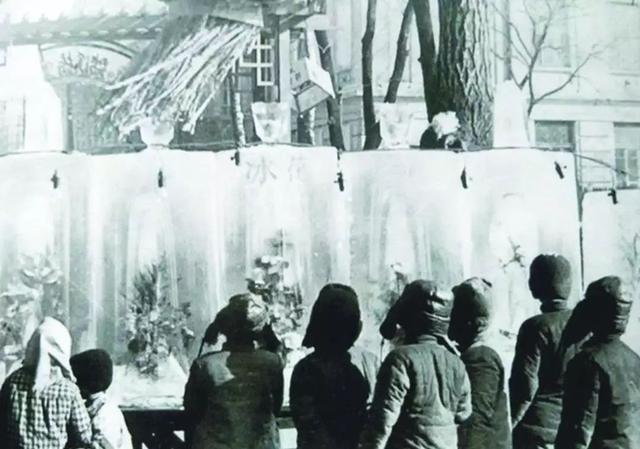
First edition of the Snow and Ice Festival in 1963.
After the Cultural Revolution put a halt to the festivities in 1966, local authorities reviewed the festival again in 1984, and revived it as an event to boost the local economy. About a decade later, it had already become one of the biggest of its kind globally, with its ice sculpting competitions and snow sculpture parks, including thousands of ice structures and spectacular lantern venues.
This 2023-2024 season turns out to be another important moment for Harbin and its ice festival. In November of 2023, the city launched a press conference in which they stressed the importance of strengthening the city’s position as an (international) leader in the field of ice and snow tourism in this post-pandemic era and fully focus on turning the season into a “people’s festival” and a “people’s event” (“使冰雪季和冰雪节真正成为人民的节日、百姓的盛会”).
From string quartets to hot air balloons, Harbin is going all out to entertain and impress visitors this year, and all the efforts are paying off.
More than two million people are expected to visit Harbin for this year’s festival, including its ‘Ice and Snow World’ (哈尔滨冰雪大世界) which opened on 18 December and will run until late February. This amusement park is a major attraction within the larger festival, and this 25th edition, with its 810,000-square-meter, is the largest-ever held.
In a time when Chinese domestic travelers are exploring their own country in new ways, from Special Force travel style to show-inspired journeys, the latest buzz surrounding Harbin is something that many simply do not want to miss out on, causing the coldest city to become one of the hottest destinations of the moment.
Turning Bad Publicity into Something Positive
On December 18, Harbin officially opened its Ice and Snow World to the public, welcoming thousands of visitors. This is also when the city and its festival first started trending on social media, but not necessarily in a good way.
Visitors initially complained that despite making reservations, they had to wait in lines at the entrance for hours, and that the time slot reservation system (分时预约) – introduced in Covid days – actually made things more difficult rather than facilitating a smoother crowd management process.
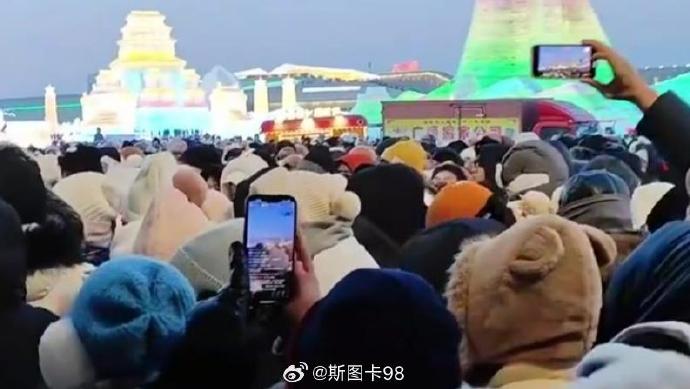
People also complained when Ice and Snow World issued a notice that they couldn’t accommodate more than 40,000 people and had already reached their limit during the early afternoon, therefore halting further ticket sales on the 18th. The 40,000 people limit seemed strange to many, who commented that other events and venues across China, such as Shanghai Disneyland, could welcome much more visitors.
People who had been waiting in line for hours starting shouting that they wanted their money back, and that incident went viral online as the “ticket refund incident” (#哈尔滨退票事件#, 170 million views on Weibo).
Not only did these incidents generate more public attention for the events taking place in Harbin, Snow World’s response also became a hot topic as they soon issued an apology, swiftly canceled the time slot reservation system, gave ticket refunds, and introduced a ‘first come first served’ system (#冰雪大世界取消预约制#, #哈尔滨冰雪大世界致歉#, 370 million views).
A side effect of this incident and how it was handled was that a so-called “underdog effect” became visible on social media, where many people started defending Harbin and Snow World. Supporters questioned whether visitors would similarly express frustration while waiting in lines at Disneyland or Universal Studios.
One Weibo blogger (@刘成春) wrote: “Please do not dismiss Harbin’s Ice and Snow World just because of some minor shortcomings. A group of simple, honest, hardworking people have spent days on end creating these sculptures with ice taken from the Songhua River at temperatures below minus 20. They’ve been making so much efforts, and Harbin just wants to present these works as gifts and the city’s signature to the people (..) Please don’t discredit the only snow and ice landmark of Northeast China.”
After the incident, this sentiment echoed widely on Chinese social media, where many believed in Harbin’s genuine efforts to make its snow and ice season a success, recognizing the sincerity and goodwill of those involved. The idea that Harbin really deserves to shine this season was further strengthened because of videos emerging on social media of previous Covid years, when the smaller festival looked empty and staff still worked hard to try and entertain the few visitors that were there.
Southern Little Potato Hype
On New Year’s Eve, videos showing celebrations in Harbin rapidly gained traction online, showing that Harbin was doing everything it could to entertain and create a welcoming atmosphere for its visitors.
Looks like Harbin is ready for 2024. 🥳 pic.twitter.com/VjBF5eQdMH
— Manya Koetse (@manyapan) December 31, 2023
These visitors have also become part of the buzz surrounding Harbin this season, mainly the emergence of the so-called “Southern Little Potatoes” (南方小土豆 nánfāng xiǎo tǔdòu). This term refers to the increasing influx of tourists from China’s warmer southern regions who are making their way to the snow-blanketed north.
The term “Southern Little Potatoes” humorously describes these southern tourists, especially women, who are frequently spotted sporting light-colored down jackets and hats. Their short height, distinct travel attire makes them stand out among the typically taller and darker-dressed locals in northeastern cities, leading to the playful potato comparison by northerners.

One of the ‘Southern Little Potatoes’ memes (via 21jingji.com).
As “Southern Little Potatoes” became a trending term online, southern tourists also started using it to make fun of themselves and it came to be used to highlight the warm and sometimes funny exchanges between the north and south.
The “Southern Little Potatoes,” who are not used to not used to ice, snow, and extremely cold weather, are also known to get into tricky situations, needing locals to help them out. On January 9, one tourist from the south went viral for stepping out of the train as he quickly wanted to experience licking a metal pole in freezing temperatures. The moment his tongue got stuck, the train staff kindly helped him get unstuck.
Just a short reminder not to lick metal poles in freezing temperatures. Some Chinese southern tourists couldn't resist the urge when visiting the cold north, but of course, these silly "little southern potatoes" (南方小土豆) need help in getting rescued. 😝 #Harbin pic.twitter.com/0bqlMMf3KQ
— Manya Koetse (@manyapan) January 10, 2024
For locals, these silly southern tourists are a great business opportunity. One street seller started offering a supervised metal pole licking experience: you can lick a small metal pole for 5 yuan ($0.70), a bigger one for 10 ($1.40), and the tallest one for 15 ($2) (photo below).
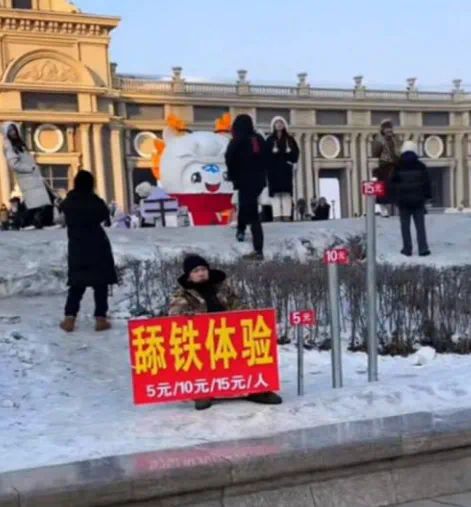
Metal pole licking experience.
The Southern Little Potato trend has set off the online meme machine, as well as sparked a small local economy. Some Harbin taxi drivers, for example, promote themselves as being designated “little potato drivers” to serve their ‘friends from the south.’ Street sellers selling ‘little potato’ plush toy keychains for 15 yuan became all the hype.

Little Potato merchandise sold in the streets of Harbin (via 21jingji.com).
You could say that this general trend has also strengthened ties between the north and south. In Chinese, Harbin (Hā’ěrbīn 哈尔滨) is now affectionately shortened to ‘Ěrbīn‘ by visitors and netizens, with the dropping of the ‘Ha’ reflecting a more casual, friendly familiarity with the city.
A Snowball Effect
Although part of Harbin’s enormous (online) success can be attributed to a snowball effect that began after December 19/20, with people showing their appreciation for the city and joining the hype, the attention on social media was also a result of a well-coordinated campaign.
As described by Chinese media outlet The Paper (澎湃新闻), Heilongjiang Province’s Cultural and Tourism Department Party Secretary and Director He Jing (何晶) recently stated in an interview: “This year’s popularity [of Harbin] isn’t accidental; we’ve been preparing for a year.” He explained how, since early 2023, they started focusing on new media and social media strategies to promote Heilongjiang and Harbin in multiple ways.
For this season, Harbin Snow World made sure there were several online influencers and celebrities promoting the festivities, such as Chinese influencers Kiki (陈洁Kiki) and Barbin (Barbin.ili芭比) or Olympic champion speed skaters Fan Kexin (范可新), Zhang Hong (张虹), and Zhang Yuting (张雨婷). There are also various brand collaborations, such as with Tencent and its Game for Peace (和平精英). Local official media channels and big state media accounts also collaborate with Harbin in posting a lot of promotional videos related to festivities.
This year, Harbin also introduced all kinds of activities and venues to increase their appeal. The ice-made terracotta warriors, for example, or the hot pot restaurant housed within an ice structure, where even the tables are sculpted from ice. These are just some of the many ‘must-experience’ attractions in Harbin that have garnered attention on Chinese social media (#哈尔滨把火锅玩出了本地特色#).
Harbin has been trending on Chinese social media every single day for two weeks now. It's the Zibo of the 2023-2024 winter season. Among all the things that are hyped, I love the idea of having spicy hotpot within an ice restaurant. Warm tummy, cold face. There's a beer bar, too! pic.twitter.com/9ea9XzXmk8
— Manya Koetse (@manyapan) January 11, 2024
There is also a 20-meter high snowman wearing a red hat, that has come to serve as a must-go photo opportunity for visitors. The local tourism ambassador, the Exploring Pinguin (淘学企鹅), with its cute appearance and orange backpack, is also one of those things that further adds to the appeal of Harbin and its Snow World.
Local authorities, including the tourism department, also pulled out all the stops to ensure visitors felt welcome and accommodated. They made sure local hotels and other business maintained fair prices despite the surge in tourists and to increase the focus on customer service.
They also made sure to listen to (online) feedback and quickly act on complaints. For example, after so many tourists from the south arrived at Harbin Airport and had to change into warmer clothing in the chilly central hall, they increased the number of airport dressing rooms, equipped with seats, mirrors, and carpets. This kind of attention to detail and drive to serve visitors is a strategy that has greatly contributed to Harbin’s current success.
You now see that the combined efforts of local authorities and businesses in Harbin, both online and offline, have cultivated a unique festive atmosphere. This atmosphere is contagious; it motivates locals to actively contribute to maintain the standards while also encouraging visitors to actively promote the city. This leads to new groups of visitors getting enthusiastic to travel to Harbin.
While this success is partly orchestrated, with authorities and state media being key players, there is also that ‘special something’ — a kind of genuine charm, sincerity, relatability, and likability — which is much harder to schedule through strategies. It’s an organic ingredient that is a major part of the buzz. In this way, Zibo and Harbin are very much alike.
Despite some criticisms about prioritizing short-term fame and social media hype for Chinese tourist destinations, it seems that Harbin’s success will be long lasting. As some social media users say: “I can’t make it this year, but I definitely will go to Harbin for the next season. I’ve never even seen snow in my life.”
By Manya Koetse, with contributions by Ruixin Zhang and Miranda Barnes
Get the story behind the hashtag. Subscribe to What’s on Weibo here to receive our newsletter and get access to our latest articles:
References
Dewar, Keith, Denny Meyer, and Wen Mei Li. 2001. “Harbin, Lanterns of Ice, Sculptures of Snow.” Tourism Management 22 (5): 523-532.
Spotted a mistake or want to add something? Please let us know in comments below or email us. First-time commenters, please be patient – we will have to manually approve your comment before it appears.
©2024 Whatsonweibo. All rights reserved. Do not reproduce our content without permission – you can contact us at info@whatsonweibo.com.
Manya is the founder and editor-in-chief of What's on Weibo, offering independent analysis of social trends, online media, and digital culture in China for over a decade. Subscribe to gain access to content, including the Weibo Watch newsletter, which provides deeper insights into the China trends that matter. More about Manya at manyakoetse.com or follow on X.
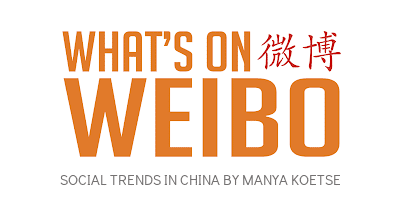
China Insight
China Reacts: 3 Trending Hashtags Shaping the Tariff War Narrative
From historic speeches to trending slogans, this is China’s official media response to the US tariff escalation.
Published
2 months agoon
April 13, 2025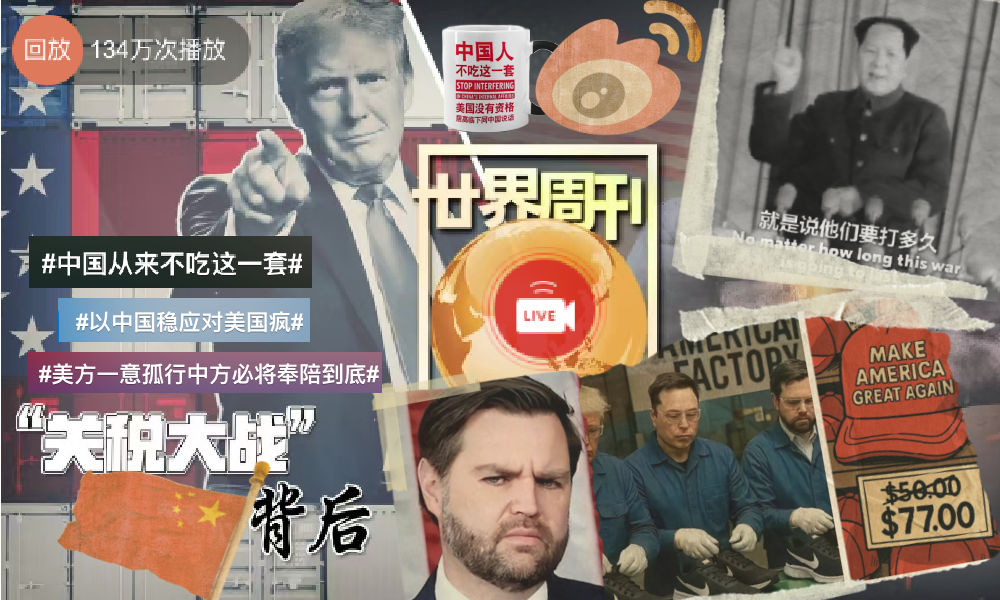
What do Mao’s 1953 Korean War speech and Yang Jiechi’s 2021 Alaska Summit remarks have to do with the escalating US–China trade war? In Chinese official media responses, history and emotionally charged rhetoric are used to clearly signal China’s stance and boost national confidence. Here, we explore three dominant narratives.
As you probably know by now, April 9 marked “D-Day” for Trump’s rollout of steep tariffs. On Chinese social media, the escalating trade war between China and the US dominated conversation, especially on that “D-Day Wednesday,” when nearly all of Weibo’s top 10 most-viewed hashtags were related to Trump’s tariffs and China’s retaliation.
Since developments are unfolding rapidly, here’s a quick recap:
- 🇺🇸💥 On Wednesday, April 2, President Trump announced steep new tariffs, including a universal 10% “minimum base tariff” on all imported goods, and an additional 34% reciprocal tariff specifically targeting China as part of the so-called “Liberation Day,” set to begin on April 9. Combined with pre-existing tariffs, this would bring the total tariff rate on Chinese goods entering the United States to over 54%.
- 🇨🇳⚔️On Friday, April 4, China’s State Council Customs Tariff Commission Office issued an announcement stating that, starting April 10, an additional 34% tariff would be levied on all imported goods originating from the United States, on top of existing tariff rates.
- 🇺🇸⚔️On Tuesday, April 8, Trump vowed to increase tariffs on Chinese exports by an additional 50% if Beijing would not withdraw its 34% counter-tariffs.
- 🇨🇳💥On Wednesday, April 9, China’s finance ministry announced it would further raise tariffs on US goods to 84% starting the following day, in retaliation for the newly imposed 104% tariff on Chinese goods.
- 🇺🇸💣On Wednesday, April 9, Trump then did a U-turn and halted the new steep tariffs for dozens of countries for 90 days, except for China, followed by yet another threat of an additional 21%, bringing those import taxes to 125%.
- 🇺🇸🚨On Thursday, April 10, it was clarified by the White House that tariffs on China would actually total 145%, combining the previously announced 125% with a 20% import tax levied for fentanyl smuggling.
- 🇨🇳💣On Friday, April 11, Chinese official channels reported that China would adjust its tariff measures on important goods from the US starting April 12, raising the rate from 84% to 125%. A related hashtag became no 1 trending topic on Weibo, where it received over 500 million views by Friday night (#对美所有进口商品加征125%关税#).
- 🇺🇸⬅️ On Friday, April 11, Trump’s administration announced that it will exempt smartphones, computers and some other electronic devices from the new tariffs, including the 125% levies imposed on Chinese imports (#特朗普政府再度退缩#; #美国免除智能手机电脑对等关税#).
There are hundreds of hashtags and trending topics circulating across Chinese platforms — from Weibo to Toutiao, from Kuaishou to Douyin — related to the latest developments in the US–China trade war. The topic is super popular, but censored comment sections and removed images also reveal just how sensitive it can be at times.
The biggest hashtags and slogans are those initiated and amplified by official channels. From press conferences to hashtags and visual propaganda, you can see a clear strategic media narrative that draws on history, national pride, and patriotism to frame recent developments, mobilize public sentiment domestically, and show China’s resilience to the rest of the world.
Here, I’ll highlight three hashtags that have recently become top trending, each representing a different kind of official narrative or rhetoric in response to the ongoing developments.
1. China Won’t Back Down
(China will see it through to the end #美方一意孤行中方必将奉陪到底#)
The message that China will not be intimidated by the US is one that echoes across Chinese social media these days, reinforced by official channels.
On April 9, the Weibo account of Chinese media outlet Guancha (@观察者网) and the state-run New Era China Foreign Affairs Think Tank (@新时代中国外交思想库) posted a video showing part of a speech given by Mao Zedong on February 7, 1953, during the final stages of the Korean War at the 4th Session of the 1st National Committee of the Chinese People’s Political Consultative Conference (CPPCC).
In the short fragment, Mao Zedong says:
🇨🇳📢 “As to how long this war will last, we are not the ones who can decide. It used to depend on President Truman, and it will depend on President Eisenhower, or whoever becomes the next US President. It’s up to them. No matter how long this war is going to last, we’ll never yield. We’ll fight until we completely triumph.”

The 1953 speech by Mao was also posted on the US social media platform X by Mao Ning (@毛宁), spokesperson for China’s Ministry of Foreign Affairs. The video was then also spread by blogging accounts and regular netizens. History blogger Zijin Gongzi (@紫禁公子), who has over 435k fans on Weibo, reposted the video, writing:
💬 “Our forefathers never bowed their heads to strong enemies. How could we easily accept defeat? (..) We must not lose this spirit, we must let everyone know that we have a strong backbone and will never bow down.”
Together with the Mao video, the hashtag used by the Think Tank and many other Chinese media accounts, such as People’s Daily (@人民日报), is “If the US obstinately clings to its course, China will fight to the end [lit. accompany them to the end]” (#美方一意孤行中方必将奉陪到底#) and “fight to the end” (#我们奉陪到底#).
These phrases in part come from a press conference given by Ministry of Foreign Affairs spokesperson Lin Jian (林剑) on April 8. Here, he said:
🇨🇳📢 “I want to emphasize once again that there are no winners in trade wars and tariff wars, and protectionism is no way forward. The Chinese people do not provoke trouble, but they are also not afraid. Pressure, threats, and blackmail are not the proper ways to deal with China. China will inevitably take necessary measures and resolutely safeguard its legitimate rights and interests. If the American side disregards the interests of both countries and the international community and insists on waging a tariff war and trade war, China will fight to the end [lit. inevitably accompany them to the end 中方必将奉陪到底].”
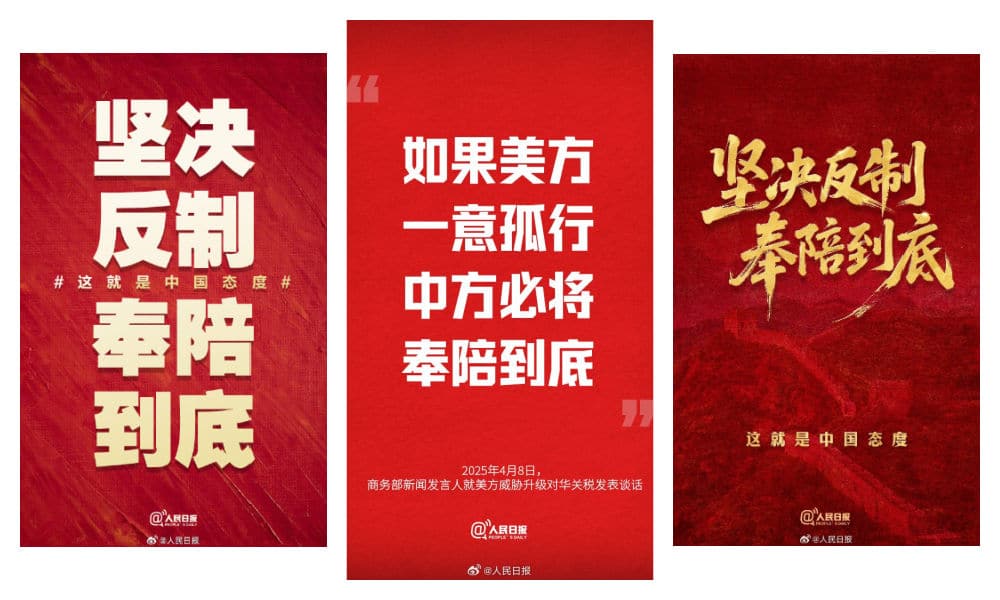
The next day, these words had been turned into digital propaganda posters, with some slight variations in the phrases used. One People’s Daily graphic underlined: “We resolutely take countermeasures, and follow through until the end (坚决反制 奉陪到底),” accompanied by the line: “This is China’s attitude,” which was also turned into a hashtag (#这就是中国态度#).
2. This Is No Way to Deal with China
(Chinese people aren’t buying it #中国人从来不吃这一套#)
Another related yet somewhat different sentiment that dominates Chinese social media—led by official channels—is that China is not only rejecting the trade games played by the US, but is also distancing itself from the American playbook. The message is: this is no way to deal with China. This narrative, and the hashtag surrounding it, emerged slightly later than the first. While the earlier phrase about China not backing down trended as China matched the US in its tariff measures, this one took off with China’s final blow—raising the rate on US imports from 84% to 125% in response to the latest US tariff hikes.
The April 11 statement on the Ministry of Finance website (财政部网站), also posted on Weibo by Xinhua News (@新华社), announced that China would adjust its additional tariff measures on imports originating from the United States effective April 12. It also stated that China strongly condemns the US imposition of excessively high tariffs and will no longer engage in further tariff escalations:
🇨🇳📢 “Given that, at the current tariff level, US goods entering China effectively have no market viability, if the US continues to raise tariffs on Chinese exports to the US, China will no longer respond.”
The main hashtag used by Xinhua and many other media channels is “中国从来不吃这一套” (Zhōngguó cónglái bù chī zhè yī tào), which can be translated as: “The Chinese people have never accepted this,” or more colloquially, “We’re not buying it.”
The phrase initially became popular in 2021, after it was used by China’s top diplomat Yang Jiechi (杨洁篪) during the first major strategic talks of the Biden administration, held in Anchorage on March 19. Due to the occasionally heated exchanges between the two delegations, some called the Alaska talks a “diplomatic clash.”
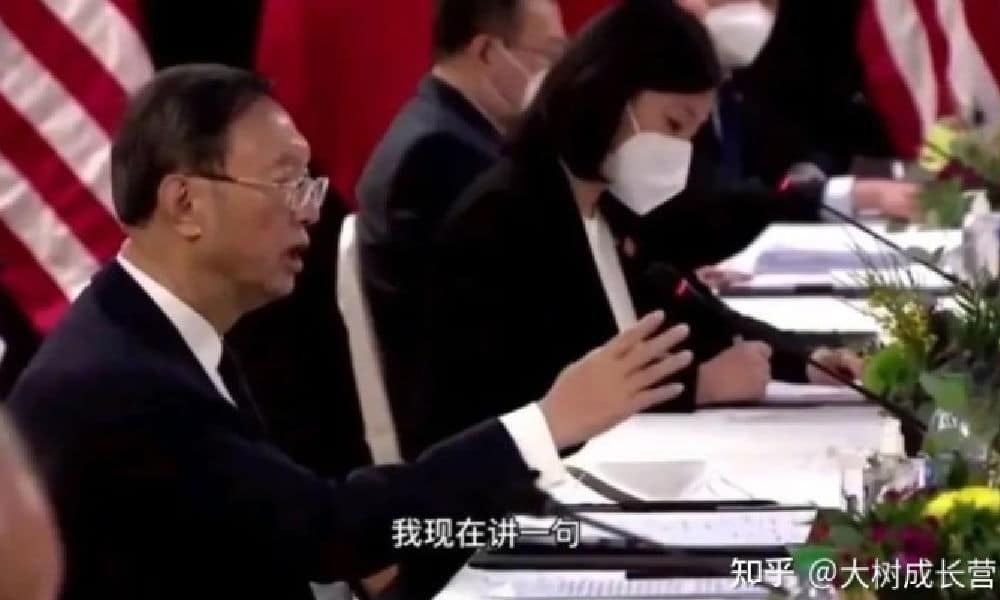
Yang Jiechi during the Alaska Summit
At the time, Yang delivered a lengthy statement to US Secretary of State Antony Blinken and National Security Advisor Jake Sullivan, stressing that Taiwan, Hong Kong, and Xinjiang are “inseparable parts of China,” and that China strongly opposes US interference in its internal affairs. Suggesting the US should focus more on its own human rights issues and racial problems instead of lecturing China, he added the now-famous line: “The US is not qualified to speak to China from a position of strength. The Chinese people don’t buy that” (美国没有资格居高临下同中国说话,中国人不吃这一套).
The phrase quickly went viral—boosted by state media, celebrated by netizens, and turned into a marketing slogan. It now appears on t-shirts, teacups, phone cases, and other patriotic merchandise.
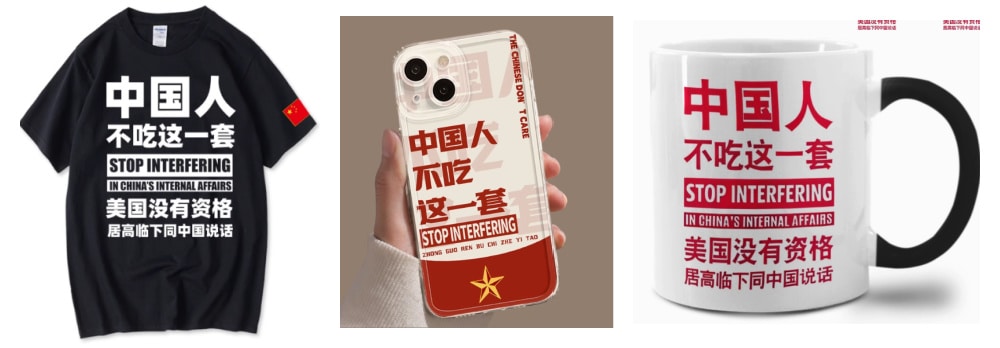
The translation of the phrase still triggers discussions. While merchandise typically translates it as “Stop interfering in China’s internal affairs,” that’s not an accurate translation. During the Alaska Summit, interpreter Zhang Jing (张京) (who gained viral fame at the time) translated it in real-time as “This is not the way to deal with the Chinese people.” However, some commentators and professional translators argued this was a missed opportunity to take a tougher stance, as the Chinese phrase is much sharper and could be loosely translated as: “We Chinese people don’t swallow this crap.”
In Alaska, Yang emphasized that dealing with China requires mutual respect, and that history will prove that trying to strangle China’s rise would ultimately hurt the US itself (“与中国打交道,就要在相互尊重的基础上进行。历史会证明,对中国采取卡脖子的办法,最后受损的是自己。”)
Similar sentiments now dominate online media discourse in China. The slogan has evolved from “The Chinese people don’t buy this” (中国人不吃这一套) to the more authoritative “China has never bought this” (#中国从来不吃这一套#)
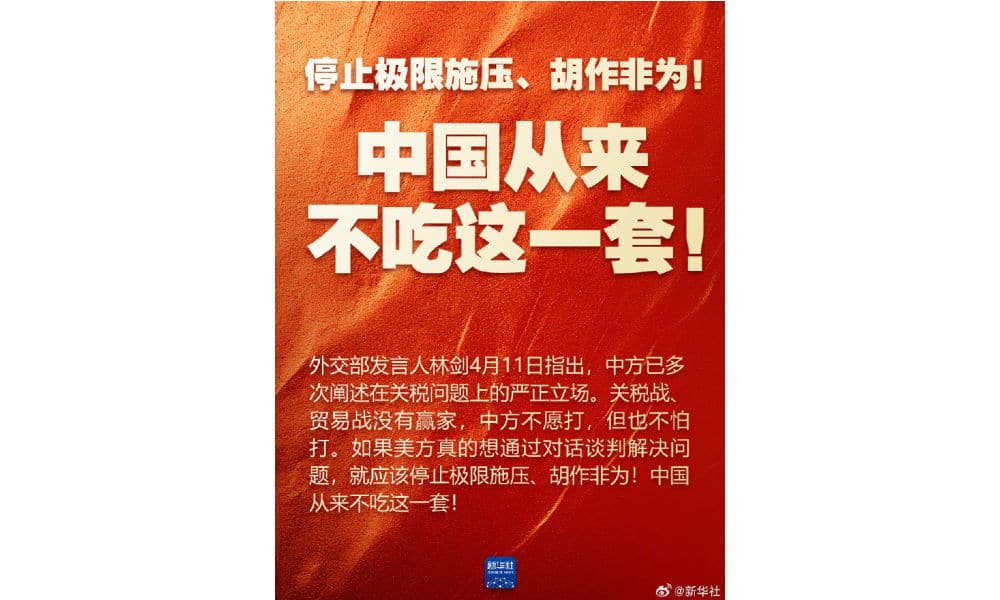
Adding fuel to this message are hashtags like “America’s repeated imposition of excessively high tariffs on China has become a joke” (#美方对华轮番加征畸高关税已沦为笑话#).
Ridiculing America (especially Trump) has become a popular pastime on Chinese social media this past week, with a flood of Chinese and international memes circulating widely.

Especially popular are memes mocking the idea of America as a future “Made-in-America” manufacturing hub, the irony of iconic American products (like MAGA hats) being made in China, and how everyday essentials such as eggs have reached historic price highs in the US (a crisis partly caused by bird flu but now worsened by the tariffs).
On April 13, the hashtag “The 145% tariff makes one panda plush toy cost 80 dollars” (#145%关税让1只熊猫玩偶卖80美元#) also went trending, sparking jokes about how even the most trivial things could suddenly become luxuries in the US.
3. China is the Most Stabile Superpower
(Countering America’s madness with China’s stability #以中国稳应对美国疯#)
A third stance that has been dominant in Chinese official online discourse is that China’s development does not rely on anyone’s favors (#中国发展从不靠谁的恩赐#, derived from a quote by Xi Jinping), and that despite the US’s measures, China’s rise on the world stage cannot be stopped. In fact, the narrative suggests that these actions by the US are only accelerating China’s ascent.
A commentary piece published by state broadcaster CCTV (@央视新闻) on April 11 quoted Professor Li Haidong (李海东) of China Foreign Affairs University, who stated that the US’s increasingly aggressive behavior reinforces the notion that it is using tariffs as a tool of extreme pressure; as a weapon to serve its own interests. According to Li, this reflects America’s hegemonic mindset, aiming to assert superiority by intentionally creating crises.
But rather than strengthening the US, the commentary argues, these recent measures are backfiring and are damaging the US’s domestic economy and undermining its global credibility.
In contrast to the US’s presumed recklessness and “hysterical approach,” China is depicted as a “responsible world leader,” bringing certainty to an uncertain world by “responding with its own stability” and proving to be, supposedly, a more reliable engine of global growth. The commentary states:
🇨🇳📢 “As the tariff storm strikes, China is using its own ‘stability’ to resist the trials and tribulations, by upholding rules, defending justice, and steering the big ship of globalization through treacherous countercurrents, toward the right path of openness and cooperation.”
To promote the piece on social media, CCTV used the hashtag “Responding to America’s madness with China’s stability” (#以中国稳应对美国疯#).
This sentiment was echoed by nationalist bloggers, such as Tangzhe Tongxue (@唐哲同学), who posted on April 13:
💬 “In this world, besides China, the rest are all just a poorly equipped small-town theater troupe (草台班子).”
The phrase “草台班子” (cǎotái bānzi) literally refers to a makeshift opera troupe performing on a shabby rural stage, and is used to describe an incompetent group of amateurs.
The blogger’s comment indirectly responds to comments made by US Vice President JD Vance, who defended Trump’s tariffs in a Fox News interview by saying: “To make it a little more crystal clear, we borrow money from Chinese peasants to buy the things those Chinese peasants manufacture.”
That remark sparked controversy online, with many netizens calling it ignorant. Some pointed out that Chinese people were already wearing fine silks when Westerners were still wrapped in animal skins fishing in the sea, and flipping the narrative to portray Americans as the real “country bumpkins.”

Meme shared online.
This sentiment was reinforced by another hashtag trending on Weibo on April 13: “You think we’re scared, but we actually don’t care” (#你以为我们scared其实我们不care#).
That line comes from a Channel 4 interview with Gao Zhikai (Victor Gao/高志凯), Vice President of the Center for China & Globalization (CCG), who stated:
🇨🇳📢 “China is fully prepared to fight to the very end. Because the world is big enough that the United States is not the totality of the market in the world. So if the United States wants to go in that direction of completely shutting itself out of the Chinese market, be my guest. [Interviewer: Yes and China will lose the US market..] We don’t care. We don’t care. China has been here for 5000 years, and for most of the time there was no United States and we survived. If the United States wants to bully China, we will deal with the situation without the United States. And we except to survive for another 5000 years.”
While this reflects the official position and is widely echoed across social media, others stress the importance of remembering history; particularly China’s “Century of Humiliation” (百年国耻), which was marked by war, aggression, and unequal treaties imposed by foreign powers. Just like other historical anniversaries, some bloggers argue that Trump’s tariff “D-Day,” April 9, should not be forgotten (“今天是每个中国人难以释怀的日子”) and that it marks another reason for China’s renewed rise.
In a video posted by CCTV’s short video platform Xiaoyang Shipin (小央视频) on April 13 (link), the narrator states:
🇨🇳📢 “The so-called global “beacon” now puts “America first.” It slaps allies in the face, treats the world with predatory practices, and makes other countries pay for MAGA, pushing the fragile word economy over the edge, and pitching itself against the whole world. With China here, the sky won’t fall. With around 5% economic growth, China adds the output of a mid-sized European economy every year. China has hundreds of millions of skilled workers. The Chinese people are well known for their strong work ethic. China’s development over the past seven decades is a result of self-reliance and hard work, not favors from others, (..) Global businesses believe the next China is still China and the best is yet to come (..) Markets need to restore faith. Between the pond of closed markets, and the ocean of economic interconnectivity, which one would you choose?”
Overall, packaged across different media — from hashtags to short videos, from press conferences to news reports, and from digital slogan posters to Ministry of Foreign Affairs tweets — China’s strategic political media messaging is clear and quite powerful, despite the fragile and censored environment it operates in: China is not afraid to strike back, China will lead with calm, and eventually, China will emerge as the winner. Whatever happens next remains to be seen, but when it comes to turning crisis into opportunity, China’s official media channels have already done just that.
By Manya Koetse
(follow on X, LinkedIn, or Instagram)
THIS ARTICLE IS PART OF WHAT’S ON WEIBO CHAPTER: “THE US-CHINA TARIFF WAR ON CHINESE SOCIAL MEDIA“
Spotted a mistake or want to add something? Please let us know in comments below or email us. First-time commenters, please be patient – we will have to manually approve your comment before it appears.
©2025 Whatsonweibo. All rights reserved. Do not reproduce our content without permission – you can contact us at info@whatsonweibo.com.
China Insight
From Trade Crisis to Patriotic Push: Chinese Online Reactions to Trump’s Tariffs
“This moment is the time to reflect on our unity. If we can choose domestic alternatives, we should.”
Published
2 months agoon
April 5, 2025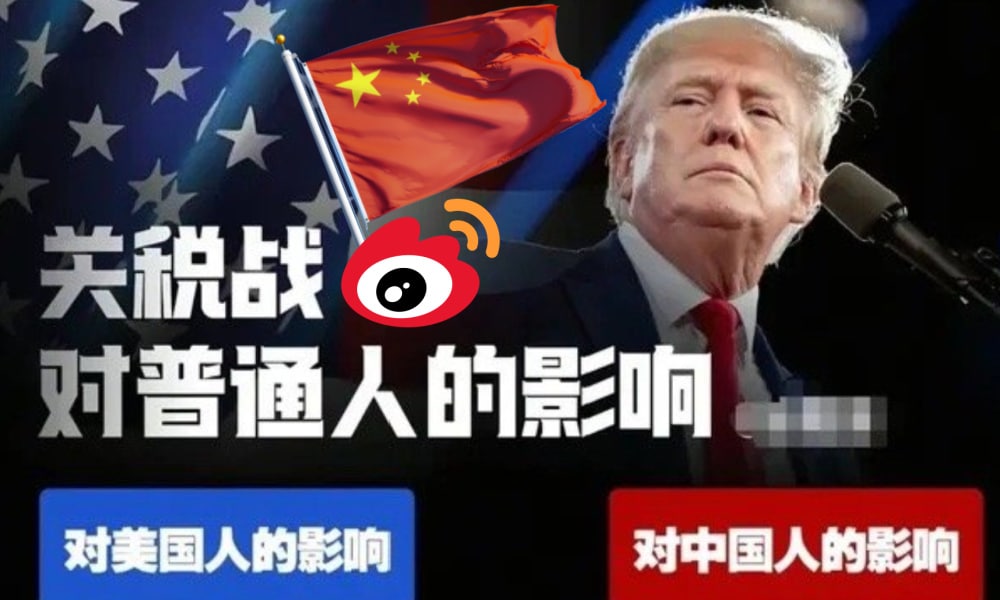
“China’s countermeasures are here” (#中方反制措施来了#). This hashtag, launched by Party newspaper People’s Daily, went top trending on Chinese social media on Friday, April 4, after President Trump announced steep new tariffs on Wednesday, including a universal 10 percent “minimum base tariff” on all imported goods and especially targeting China with an additional 34% reciprocal tariff as part of so-called “liberation day.”
Countermeasures were announced on Friday. China’s State Council Customs Tariff Commission Office (国务院关税税则委员会办公室) issued an announcement stating that, starting from April 10, an additional 34% tariff will be levied on all imported goods originating from the United States, on top of existing tariff rates.
Other countermeasures include immediate export restrictions on seven key medium to heavy rare earth elements, which are important for manufacturing critical products used in semiconductors, defense, aerospace, and green energy.
“This won’t make America great again”
The official response to the tariffs, both from state media and the government, has been twofold: on the one hand, it criticizes the U.S. for placing American interests above the good of the global community, arguing that the move only hurts the U.S., its people, and the world. On the other hand, the Chinese side stresses that although they do not believe tariff wars are the answer, China is not afraid of a trade war and will not sit idly by, but will respond with equal measures.
Chinese official media have condemned the new tariffs, which led to the largest single-day market drop in years. Describing the reactions of various experts, Xinhua News highlighted a comment by a Croatian professor, stating that the policy will only increase export prices and worsen inflation, ultimately hurting middle- and working-class Americans — and noting that the policy “won’t make America great again” (不会“让美国再次伟大”).
The official announcement by Chinese state media regarding China’s countermeasures received widespread support in its (highly controlled) comment sections, with both media outlets and netizens echoing the message that China will not be bullied by the U.S.
On Xiaohongshu, similar sentiments shnone through in popular posts, such as one person writing:
💬 “Congratulations to the U.S. on receiving a 34% tariff on all its goods! Luckily, very few of the things ordinary Chinese people eat or use come from the U.S. anyway.
#RMB purchasing power #China will inevitably be unified #Consumer confidence #Contemporary Chinese economy #Carrying forward the construction of a Beautiful China”

“Monday’s stock market will be a bloodbath,” another commenter wrote.
One Weibo blogger (@兰启昌) saw the recent developments as another sign of an ongoing trend of “de-globalization” (逆全球化).
But beyond global economics and geopolitics, many Chinese netizens — from Weibo to Xiaohongshu — seem more focused on how the new policies will affect everyday consumers.
Netizens have been actively discussing which goods will be hit hardest by the new tariffs. Based on 2023 trade data, here’s a breakdown of the top exports between China and the United States — and the sectors most likely to feel the impact.

🔷🇺🇸🇨🇳Top 10 Chinese Exports to the U.S.
1. Electronics and Machinery
Includes smartphones, laptops, tablets, integrated circuits, and image processing equipment.
2. Furniture, Home Goods & Toys
Such as video game consoles, lamps, and much more.
3. Textiles and Apparel
Garments, footwear, and accessories like sunglasses.
4. Metals and Related Products
Especially steel and steel-based items.
5. Plastic and Rubber Products
Widely used in packaging, manufacturing, and consumer goods.
6. Transportation Equipment
Electric vehicles, passenger cars, motorcycles, scooters, and drones.
7. Low-Value Commodities
Bulk items used in general trade and low-cost manufacturing.
8. Chemicals
Industrial chemicals and related materials.
9. Medical and Optical Instruments
Includes medical devices and precision instruments.
10. Paper Products
Ranging from office supplies to industrial paper goods.
🔹🇨🇳🇺🇸Top 10 U.S. Exports to China
1. High-Tech Machinery and Electronics
Especially integrated circuits, turbine engine components, and semiconductor manufacturing equipment.
2. Energy Products
Crude oil, liquefied propane and butane, natural gas, and coking coal.
3. Chemicals and Pharmaceuticals
Includes cosmetics, cleaning agents, and various medical drugs.
4. Soybeans
A key agricultural export widely used in food and animal feed in China.
5. Transportation Equipment
Such as automobiles and aircraft parts.
6. Medical and Optical Devices
Medical precision equipment, diagnostic tools, and lab instruments.
7. Plastic and Rubber Goods
Used in both consumer and industrial sectors.
8. Metal Products
Primarily iron and steel exports.
9. Wood and Pulp Products
Lumber, wood pulp, charcoal, and paper goods.
10. Meat
Including beef, pork, and poultry.
Those doing trade with the US, or otherwise involved in made-in-China products, like those working clothing and furniture factories, will inevitably be affected by the tariffs.
“Patriotism isn’t just a sentiment – it’s an action”
Much of the popular online conversation has focused on concrete examples of what kinds of things might get more expensive for Chinese consumers in their everyday lives.
Some bloggers noted that people might start to see price hikes in everyday groceries like dairy, meat, corn, and soybeans. With fewer soybeans coming in from the US, cooking oil prices may also rise.
China is the world’s largest consumer of soybeans, but because domestic production is relatively low, soybeans remain a key import.
Then there are popular American brands in the Chinese market that are expected to get pricier too — like beauty and health products, Starbucks coffee, or Häagen-Dazs ice cream.
Some also predicted a 30% to 40% increase in prices for iPhones and other Apple products.
Contrary to the earlier comment by the Xiaohongshu blogger, some netizens explain just how many American products are actually used by Chinese consumers, with many American companies operating in China — from McDonald’s and Coca-Cola, Walmart to Disney or Warner Brothers, Procter & Gamble to Colgate and Estée Lauder.
What’s noteworthy in these discussions, however, is a strong tendency to point to Chinese alternatives and encourage smart buying instead of following hypes (“理性替代,拒绝跟风”): No need to panic about soybeans — there are domestic alternatives, and China’s own soybean program is getting a boost. Who needs Starbucks when there’s Luckin Coffee? Why buy an iPhone when you can get a Huawei? Skip the Tesla, go for a BYD.
In these discussions, the ‘crisis’ is turned into an ‘opportunity’ for Chinese companies to focus even more on the Chinese market, and for Chinese consumers to, more than ever, actively embrace and celebrate local brands and made-in-China products.
One Chinese blogger (@O浅夏拾光O) wrote:
💬 “This moment is the time to reflect on our unity. If we can choose domestic alternatives, we should. For example, we can use rapeseed oil or peanut oil instead of imported soybean oil; we can buy cost-effective Chinese electronics instead of foreign brands. Support domestic products and respond to the nation’s call to expand domestic consumption.
We must have faith in our country. Only by uniting as one, young and old all together, the entire country working together, can we withstand all hazards. As Professor Ai Yuejin (艾跃进) once said, patriotism isn’t just a sentiment – it’s an action. As long as our core is stable and we are united in spirit, no hardship can defeat us.”
Despite the major happenings and the big words, some people just care about the small things: “As long as KFC and McDonald’s don’t raise their prices, it’s all fine by me.”
See the follow-up to this article here.
By Manya Koetse
(follow on X, LinkedIn, or Instagram)
Spotted a mistake or want to add something? Please let us know in comments below or email us. First-time commenters, please be patient – we will have to manually approve your comment before it appears.
©2025 Whatsonweibo. All rights reserved. Do not reproduce our content without permission – you can contact us at info@whatsonweibo.com.
Subscribe

Lured with “Free Trip”: 8 Taiwanese Tourists Trafficked to Myanmar Scam Centers

10 Viral Chinese Phrases You Didn’t Know Came From Video Games

Earring Gate: Huang Yangdiantian and the 2.3 Million RMB Emerald Earrings

Guming’s 1 Yuan Ice Water: China’s Coolest Summer Trend

A Love Never Lost: The Historical Drama That Took Five Years (and a Run-In with Censors) to Finally Air

China Is Not Censoring Its Social Media to Please the West

IShowSpeed in China: Streaming China’s Stories Well

China Reacts: 3 Trending Hashtags Shaping the Tariff War Narrative

US-Russia Rapprochement and “Saint Zelensky”: Chinese Online Reactions to Trump’s Shake-Up

Chinese New Nickname for Trump Mixes Fairy Tales with Tariff War

Squat or Sit? China’s Great Toilet Debate and the Problem of Footprints on the Seat

China Trending Week 15/16: Gu Ming Viral Collab, Maozi & Meigui Fallout, Datong Post-Engagement Rape Case

Strange Encounter During IShowSpeed’s Chengdu Livestream

How Ne Zha 2’s Shen Gongbao Became Known as the Ultimate “Small-Town Swot”

No Quiet Qingming: From High-Tech Tomb-Sweeping to IShowSpeed & the Seven China Streams
Get in touch
Would you like to become a contributor, or do you have any tips or suggestions? Get in touch here!
Popular Reads
-

 China Media11 months ago
China Media11 months agoA Triumph for “Comrade Trump”: Chinese Social Media Reactions to Trump Rally Shooting
-

 China Society8 months ago
China Society8 months agoDeath of Chinese Female Motorcycle Influencer ‘Shigao ProMax’ Sparks Debate on Risky Rides for Online Attention
-

 China Memes & Viral11 months ago
China Memes & Viral11 months agoThe “City bu City” (City不City) Meme Takes Chinese Internet by Storm
-

 China Society11 months ago
China Society11 months agoHero or Zero? China’s Controversial Math Genius Jiang Ping




